
The
UNEXPLAINED
Mysteries of Mind Space and Time
 |
The
|
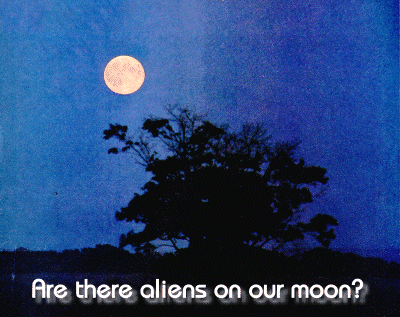 The
Moon has always puzzled Man. The intensive studies of the American and Soviet
space programmes have solved some of its ancient mysteries, but many - even
the basic riddle of the Moon's origin - continue to puzzle scientists. However,
two American writers, George H. Leonard and Don Wilson, believe that space
researchers know more than they will admit - and that they are co-operating
to cover up a terrifying fact: the Moon, right on our doorstep in space,
is inhabited by alien intelligences. NIGEL HENBEST investigates the evidence
for this amazing claim.
The
Moon has always puzzled Man. The intensive studies of the American and Soviet
space programmes have solved some of its ancient mysteries, but many - even
the basic riddle of the Moon's origin - continue to puzzle scientists. However,
two American writers, George H. Leonard and Don Wilson, believe that space
researchers know more than they will admit - and that they are co-operating
to cover up a terrifying fact: the Moon, right on our doorstep in space,
is inhabited by alien intelligences. NIGEL HENBEST investigates the evidence
for this amazing claim.
THE MOON IS A SMALL WORLD, one quarter the Earth's size, one eightieth the Earth's weight. It is a wilderness of barren rocks, piled up in circular rings called craters. Long sinuous mountain ranges stand Out like naked spines, many reaching greater heights than Mount Everest despite the Moon's small size.
Between the mountains stretch huge, flat plains, hundreds of miles across. Their dark, drab expanses are so vast that they can be seen even with the unaided eye. The first astronomers to view the Moon through telescopes thought their flatness showed them to be oceans, and these dark areas still bear names like the Sea of Tranquillity (usually known by the Latin version Mare Tranquillitatis) and the Ocean of Storms (Oceanus Procellarum). But these 'seas' (maria in Latin) are smooth plains of dry rock. The Moon has no water; it has no air. It appears unlikely that any form of life as we know it could survive there.
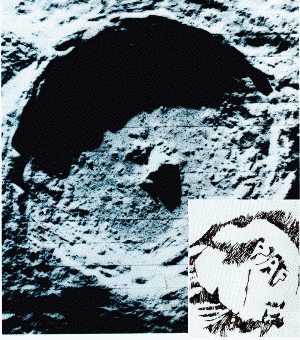 |
| The crater Tycho, in an official NASA photograph (top) and in an illustration from George H. Leonard's book Someone else is on our Moon (above). Leonard believes that the letters PAF constitute an intelligible message. On the crater floor he also sees structures that may be, he claims, collectors of solar energy - and, holding together parts of the outer skin of the Moon, an enormous screw |
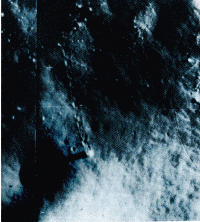 |
| Above: tracks made, claims' Leonard, by two moving objects, close
to the Vitello crater. The tracks are 900 and 1200 feet (275 and 365 metres)
long - and, since NASA claims the surface of the Moon is not disturbed by
seismic activity, and the smaller object appears to have moved uphill out
of a crater, Leonard concludes that the objects were moved by intelligent
beings |
Astronomers decided that the Moon is a hostile, barren, airless boneyard of a world even before the Apollo II astronauts reached it. From orbit close to the Moon, astronauts saw at first hand the bare desolation of that world. Clad in tough spacesuits to keep in their vital air supplies, they clambered down to the colourless, drab, grey surface under a black sky. They felt the barren quality of their surroundings; and the lunar rocks they brought back to Earth showed that the Moon is a dead world, that has remained unchanged for billions of years.The astronauts went to the Moon not just to feel its oppressive majesty, but to wrest away some of its secrets. They left instruments on the lunar surface to 'sniff' for any gases that might appear in the vacuum that takes the place of lunar atmosphere, to 'feel' for shakes of the ground that would tell of moonquakes. And they brought back a third of a tonne of Moon rocks for scientists to probe in minute detail in the laboratory. Three unmanned Soviet spacecraft have also landed on the Moon, dug up its soil and returned small samples to Earth without the danger of a manned expedition - if without the glamour.
This scientific crackdown should have solved the mysteries of our natural satellite once and for all. But in fact it has raised as many questions as it has answered; and these questions will prove even harder to answer. Even the Moon's origin is still in doubt. For over a century, some scientists have believed that the Moon was split off from our Earth in the early chaotic history of the solar system and was flung out into space as our only natural satellite. Others have thought that the Moon formed close to our Earth, born out of the same cloud of whirling gases and dust. A third school of thought sees the Moon as born elsewhere in the solar system. After wandering through space as a planet in its own right, it was caught by Earth's gravitation and forced to be its satellite. The Apollo missions have not even decided which of these theories is correct - if any.
Among the huge amount of information about our satellite, independent thinkers have found evidence to support a number of unorthodox opinions. The most common is the idea that the Moon is not as dead as it seems. Perhaps it did once support some kind of life; perhaps it still does. Perhaps alien life-forms even live on our Moon - and may even have brought it within the Earth's orbit from the depths of space.
Billion-dollar cover up
American writer George H. Leonard is convinced that aliens are on our Moon.
In his book Someone else is on our Moon, Leonard claims that huge machines
are excavating its surface, digging out craters. They have erected enormous
living-domes and towers, and they have driven huge screws, miles long, slantingly
into the Moon's crust. They have even stitched together great rents in the
lunar surface.
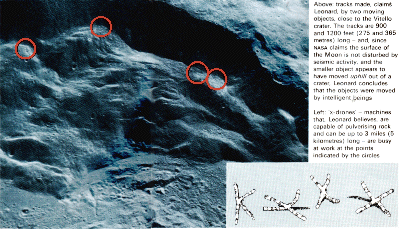 |
Left: 'x-drones' - machines that, Leonard believes, are capable of pulverising rock and can be up to 3 miles (5 kilometres) long are busy at work at the points indicated by the circles |
He is convinced that the American space agency NASA is covering up its knowledge of these aliens, and that the Apollo astronauts had jargon terms to describe the artificial constructions so their radio transmissions would not give away the news of alien occupation. According to Leonard, the multi-billion-dollar Moon landings were not planned for any scientific purpose, nor even for the political prestige of winning the 'Space race': the US and USSR governments were acting together in clandestine agreement to discover just what the extra-terrestrials on our Moon were doing. And when they found huge, powerful alien machines, but still could not discover their purpose,the governments clamped down on their results, and NASA told the world it had 'finished with manned landings for the moment.
Leonard bases his hypothesis on his own study of thousands of close-range photographs, many of them taken by the Apollo astronauts and by the earlier unmanned Orbiter probes of the 1960s. He claims that his interpretation is backed by 'Dr Sam Wittcomb', a pseudonym for someone once employed by NASA. All the evidence is from published NASA photographs, but Leonard's artefacts can be seen only on close examination with a magnifying glass. He says 'two square inches [12 square centimetresj of territory on the glossy photographs put out by NASA can keep one busy for weeks, and at the end of that period one may have only a glimmering of knowledge about half the area.'
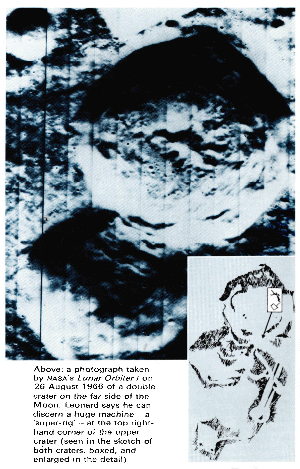 |
|
| Left: a photograph taken by NASA'S Lunar Orbiter on 26 August 1966 of a double crater on the far side of the Moon Leonard says he can discern a huge machine a 'super-rig' at the top right hand corner of the upper crater (seen in the sketch of both craters, boxed, and enlarged in the detail) Above: Leonard claims that a platform with a dome is casting the narrow triangular shadow in this photograph of the Herodotus mountain range | |
Navigation lines for UFOS
Leonard claims the photographs show objects so regular that they must be
artificial. In a mountainous region near the crater Bullialdus he has picked
out a huge set of gear wheels, the largest 5 miles (8 kilometres) across,
and a 'generator' comparable in size. Within the prominent crater Tycho he
sees an artificial covered region, octagonal in shape, with the letters PAF
written in huge script on it. Other letter-like 'glyphs' appear elsewhere
on the lunar surface. The most common are As, Xs and Ps; Leonard has also
spotted letters from the ancient runic alphabet, and one that appears like
'an old Hindu S joined to a Semitic S'. He conjectures that these letters
act as location markers to identify particular craters to aliens flying over
them in UFOs.
Inside one crater marked by such glyphs Leonard has located half a dozen UFOS on the ground. They are ovals 150 to 200 feet (45 to 6o metres) across, and the one at the crater's centre is touching 'another glowing object, shaped like an electric light bulb. One could speculate with a fair amount of confidence that the oval object ...is somehow being serviced by the other object.' The other UFOS are waiting their turn, like cars in a filling station. Each oval carries a v-shaped mark- ing, 'similar to an ancient Semitic z', or to 'the tree of life'. Reversing the upward strokes on they produces a shape similar to a marking on the famous Socorro UFO (pages 8-9), seen by a policeman in New Mexico.
Lunar construction work
Leonard's claims for alien excavators are even more startling. The most common
are the 'x-drones'. These are constructed of two crossed tubes, making an
x shape, and the largest measure 3 miles (5 kilometres) across. Leonard has
found x-drones on ridges and the rims of craters and on crater floors. They
seem to be breaking up the underlying rocks by flailing at them with maces
chained to the ends of their legs. Other x-drones 'spray' out the excavated
dust. Leonard has found a team of x-drones systematically destroying a mountain
19,000 feet ~58oo metres) high, while others are excavating craters up to
4 miles (6 kilometres) in size. Each of the latter is marked bv a white cross,
which, he claims, savs to travellers who know its meaning 'There is an x-drone
working here.'
There are other e'xcavators, too, according to Leonard. He has spotted two 'super- rings', like human mechanical scoops, but several miles across. One of these pictures was taken by the Apollo 14 crew, and Leonard is convinced that they must have seen it - and intentionally kept it quiet by using codewords such as 'Annbell' and 'Barbara'.
 |
| Above: an illustration from Don Wilson's book Our mysterious spaceship Moon. He believes that the geometrical arrangements of rocks in this area to the west of the Sea of Tranquillity show them to be menhirs placed on the Moon by intelligent beings |
Another writer who believes that NASA is Iconcealing information is. Don Wilson, author of Our mysterious spaceship Moon. He, too, notes strange structures on the Moon, but he pulls in a much wider range of the Apollo discoveries to back his own hypothesis. Wilson believes that the Moon is partially hollow: it is a spaceship from the remote depths of the Universe, flown to the solar system by its alien crew. Wilson claims a respectable source for this theory, 'two senior scientists - Mikhail Vasin and Alexander Shcherbakov - at the Soviet Academy of Sciences', and he quotes their original article 'Is the Moon the creation of intelligence?', which first appeared in July I1970 in the magazine Sputnik. Since there are objections to all conventional theories of the Moon's origin, Vasin and Shcherbakov propose that it was put there by aliens, whose spaceship it was. The surface we see is merely an outer skin, the true surface being 50 miles (go kilometres) further down. The aliens left themselves headroom of 30 miles (50 kilometres) and constructed a continuous outer skin 20 miles (30 kilometres) thick to act as a screen against meteorites. On top of this tough shell is a layer of loose packing the lunar surface - a few miles thick.
Wilson claims that the theory explains many of the 'mysteries' of the Moon. The craters are shallow compared with their width: on the spaceship hypothesis, the meteorites hitting the Moon were unable to penetrate the tough shell, and merely blasted away the thin loose rock covering to make wide but shallow hollows. The smooth lava plains are 'cernent-type material' pumped out by the aliens to patch up dents left by such impacts. According to the Russian scientists, the Moon has a lower density than the Earth because it is partially hollow.
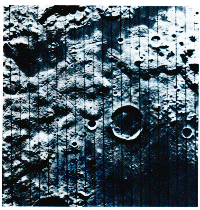 |
| Above: Leonard can see a number of features in this photograph of the Mare Veris, Mare Orientale and Rook Mountains area of the Moon's surface that he has no hesitation in identifying as the constructions of intelligent beings. They include a dome on an 'architected' platform and parallel walls joined by an arch |
Damaged alien spaceship?
Wilson accepts these interpretations wholesale, and adds his own interpretation
of some of the 'surprises' revealed by the Apollo missions. These include
discrepancies between the ages of Moon rocks and Earth rocks, and between
Moon rocks and the lunar soil they lie on. Wilson concludes that the Moon
is older than the Earth, and picked up 'younger' rocks as it travelled through
'differing cosmic time zones'. The Moon's chemical composition is not the
same as the Earth's, and Wilson suggests that the surface layers were turned
inside out when the aliens hollowed out the region below the outer shell
to make their living space.
But is the Moon still inhabited? Wilson disinters the 70-year-old ideas of an Austrian engineer called Hans Hoerbiger - ideas, incidentally, that formed part of what little philosophical background there was to Nazism. Hoerbiger thought the Earth has had more than one moon, and that our present Moon appeared only 13,500 years ago. Wilson conjectures that the aliens turned up in their damaged spacecraft, converted Earth's previous moon into a new ship, and then departed in their new craft. (He doesn't point out, however, that this still leaves the problems of accounting for the previous moon's origin.)
Wilson believes that these aliens visited Earth while they were in our vicinity, and high in the Andes they founded the now deserted city of Tiahuanaco (translated by Wilson as 'the city of the doomed satellite'). But he also discusses evidence for the Moon still being under alien occupation. He doesn't see Leonard's x-drones, super-rigs or letter-like glyphs, but he has spotted high 'spires', 'blocks' and 'domes'. Wilson relies more on the Apollo astronauts' comments, interpreting any departure from straightforward English as a cover-up code. Even if one accepts Wilson's suspicions of NASA'S honesty, though, this approach does not tell us what they did see.
Astronomers are convinced that our Moon is a dead world, for long inactive in a geological sense, a satellite that has never harboured life. For a few independent thinkers, however, the silver orb of our night skies is a more frightening world. They see it as an abode of weird, powerful aliens right on our doorstep in space.
Can scientists refute the theories of Leonard and Wilson? See page 718
Sue Blackmore UFO Aliens and Departed Spirits Little Green men or Not? The Moon
Reproduced from THE UNEXPLAINED
p661